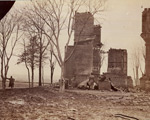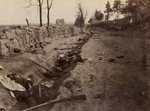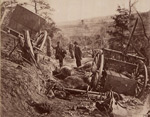Click Center Image for Full Size Picture
In his April 18, 1862, letter, Cheney expressed his opinion that the war would end sooner if the Union Army either confiscated or destroyed the property of Southern civilians. It would be two more years before such an idea would be formally used by leaders in Washington during the campaigns of 1864.
With the nation divided and war imminent in 1861, Union leaders sought a strategy, a plan, on how to restore the Union. Military thought of the day held to three main strategies:
(1) destroy the enemy army in a great battle,
(2) seize strategic sites, or
(3) capture the enemy capital.
The most famous plan developed in 1861 was General Winfield Scott's "Anaconda Plan" that called for a blockade of the South, followed by seizing control of the Mississippi River to split the Confederacy. Although Scott's two main points were enacted, Union leaders in the Eastern Theater focused on capturing the Confederate capital of Richmond while protecting Washington, D.C. The search for a great, decisive battle and attempts to seize key locations were also employed by Union generals in the field.
Gradually two other strategies were used in what General William T. Sherman called "hard war" and what later scholars would call "total warfare":
(1) destroying the enemy economy, and therefore their ability to make war, and
(2) breaking the will of the people to continue the war.
Sherman demonstrated these strategies most dramatically during his "March to the Sea" in 1864, but it was also employed by General Philip Sheridan in the Shenandoah Valley that same year and during Sherman's similar march through the Carolinas in 1865.
Pittsburg, Tennessee.





